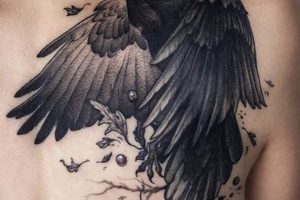Permanent body art expressing spiritual beliefs takes many forms, from intricate depictions of deities to minimalist symbols representing faith. Examples include crosses, praying hands, scriptural verses, or imagery specific to a particular religion, such as mandalas or lotus flowers.
Such permanent displays of faith can serve as powerful reminders of personal values, offer comfort and strength, and provide a tangible connection to one’s chosen belief system. Historically, permanent body art has held spiritual significance in various cultures, serving as rites of passage, protective talismans, or expressions of devotion. This enduring practice reflects a deep human need to externalize and embody internal beliefs.
Further exploration of this topic will cover specific design concepts within various faiths, the process of selecting appropriate imagery, and important considerations for individuals contemplating permanent spiritual markings.
1. Symbolism
Symbolism lies at the heart of spiritually-themed body art. Each image carries profound meaning, connecting the individual to a specific faith or belief system. Careful selection of symbolic representation is crucial; the chosen design must resonate deeply with the individual’s spiritual understanding. For example, the Dharma wheel in Buddhism represents the Buddha’s teachings and the path to enlightenment, while the Star of David serves as a powerful symbol of Judaism and Jewish identity. The Ankh, an ancient Egyptian hieroglyph, symbolizes eternal life and is often incorporated into designs representing spiritual continuity. Understanding the historical and cultural context of these symbols ensures their respectful and accurate representation.
The effectiveness of such designs hinges on the clarity and recognizability of the chosen symbol. A simple cross can hold profound meaning for a Christian, while a complex depiction of a Hindu deity may resonate deeply with a follower of Hinduism. The size and complexity of the design can also influence its symbolic impact. A small, discreet symbol might represent a private and personal connection to faith, while a larger, more elaborate design could signify a more public declaration of belief. Consideration of the specific symbolism within a chosen faith tradition is paramount to creating a meaningful and impactful representation.
Effective symbolic representation requires research and understanding. Consultation with religious leaders or experts can provide valuable insights into appropriate imagery and its cultural significance. This research ensures the chosen symbol accurately reflects the individual’s beliefs and avoids misinterpretations or cultural insensitivity. Ultimately, the power of symbolic body art lies in its ability to express profound spiritual beliefs in a visual and enduring form.
2. Placement
Placement of permanent body art expressing spiritual beliefs carries significant weight, impacting both visibility and personal meaning. The chosen location on the body can amplify the symbolism of the design and reflect the individual’s relationship with their faith. A tattoo placed on the wrist, for instance, might serve as a constant personal reminder of one’s beliefs, while a more visible placement, such as the forearm, could indicate a desire to share one’s faith with others. The decision to place a tattoo in a discreet location versus a more prominent one often reflects the individual’s comfort level with expressing their beliefs publicly.
Practical considerations also influence placement decisions. Certain professions may require tattoos to be covered, necessitating placement in areas easily concealed by clothing. Additionally, the curvature and movement of different body parts can affect the visual presentation of the design over time. A skilled artist can advise on optimal placement to ensure the integrity and aesthetic appeal of the tattoo are maintained. Factors such as pain tolerance also play a role, as certain areas of the body are more sensitive than others. For example, rib cage tattoos are often considered more painful than those on the forearm, influencing placement choices.
Ultimately, thoughtful placement enhances the personal and spiritual significance of the tattoo. By considering visibility, practicality, and the symbolism associated with different body parts, individuals can ensure their chosen design effectively communicates their beliefs and resonates deeply with their personal journey of faith. The body becomes a canvas, and placement acts as a crucial element in narrating the individual’s spiritual story.
3. Artistic Style
Artistic style significantly influences the impact and interpretation of permanent body art representing spiritual beliefs. Different styles evoke distinct emotions and convey varying levels of reverence. A photorealistic depiction of Jesus, for example, might convey a sense of traditional devotion, while a minimalist line drawing of a cross could suggest a more modern and understated approach to faith. The chosen style should align with the individual’s personality and the specific message they wish to convey. Abstract representations of spiritual concepts, such as swirling patterns or geometric shapes, can offer a unique and personalized expression of belief. Similarly, incorporating elements of traditional religious iconography, like stained glass or illuminated manuscripts, can create visually striking and meaningful designs. Tribal styles, with their bold lines and intricate patterns, can be adapted to represent spiritual themes from various cultures, offering a powerful connection to ancestral traditions.
Selecting an appropriate artistic style also involves considering the skill and specialization of the tattoo artist. Artists often excel in specific styles, such as realism, traditional, or geometric. Choosing an artist proficient in the desired style ensures the final result effectively captures the intended aesthetic and symbolic meaning. For instance, an artist specializing in black and grey realism might be ideal for a portrait of a religious figure, while an artist with expertise in watercolor techniques could create a vibrant and evocative depiction of a sacred flower. Researching an artist’s portfolio and discussing design ideas thoroughly are essential steps in achieving a successful outcome. The collaboration between the individual and the artist plays a vital role in translating spiritual concepts into visually compelling and personally meaningful body art.
The interplay between artistic style and spiritual symbolism creates a powerful medium for self-expression and connection to one’s faith. A well-chosen style enhances the visual impact of the design and contributes to its overall meaning. By carefully considering the emotional resonance and cultural context of different artistic styles, individuals can ensure their chosen design authentically reflects their beliefs and serves as a lasting testament to their spiritual journey.
4. Cultural Sensitivity
Cultural sensitivity plays a crucial role in the selection and design of permanent body art expressing spiritual beliefs. Religious imagery often carries deep cultural significance, and incorporating such imagery without proper understanding can lead to misrepresentation or cultural appropriation. Consideration of the historical and cultural context of religious symbols is paramount. For example, using indigenous spiritual symbols without a genuine connection to that culture can be disrespectful and trivialize their sacred meaning. Similarly, incorporating elements from a religion one does not practice, without a deep understanding of their significance, can be seen as culturally insensitive. A tattoo of a Buddha, for instance, holds profound meaning within Buddhism and should not be taken lightly by those outside the faith. Appropriate research and respectful engagement with the culture associated with the chosen imagery are essential to avoid causing offense or misrepresenting a belief system. This respect extends to the placement of the tattoo as well; certain symbols might carry specific placement traditions within their culture of origin.
Practical applications of cultural sensitivity include consulting with religious leaders or cultural experts before committing to a design. Engaging in dialogue with those who hold the specific beliefs associated with the chosen imagery can provide valuable insights and help avoid unintentional disrespect. This consultation can also offer a deeper understanding of the symbol’s meaning and its appropriate representation within the specific cultural context. Additionally, research into the historical and artistic traditions associated with the chosen religion can inform design choices and ensure a respectful and accurate representation. For example, understanding the traditional use of color and iconography within a particular faith tradition can help create a design that is both aesthetically pleasing and culturally sensitive. By engaging in respectful dialogue and thorough research, individuals demonstrate a genuine appreciation for the cultural significance of the chosen imagery.
Respectful representation of religious beliefs through permanent body art requires careful consideration of cultural context and potential sensitivities. Failing to engage with the cultural background of chosen imagery can perpetuate harmful stereotypes, misrepresent religious beliefs, and cause offense. Cultural sensitivity is not merely a matter of avoiding offense, but also an opportunity for deeper engagement with and appreciation of the rich tapestry of human spiritual expression. Thoughtful consideration of cultural context ensures the chosen design serves as a respectful and meaningful representation of personal beliefs, fostering understanding and appreciation for the diverse expressions of faith found across cultures.
Tips for Religious Tattoo Ideas
Careful planning ensures a meaningful and respectful representation of faith through permanent body art. Consider these essential tips before committing to a design.
Tip 1: Research Thoroughly: Deepen understanding of chosen symbolism. Explore diverse interpretations and cultural contexts associated with the intended imagery. For example, research the specific meaning of a Sanskrit mantra before incorporating it into a design.
Tip 2: Consult with Religious Leaders or Experts: Seek guidance from those knowledgeable about the specific faith tradition. This ensures respectful representation and avoids potential misinterpretations of sacred symbols.
Tip 3: Choose a Skilled Artist: Select an artist experienced in the desired style and comfortable working with religious themes. Review portfolios and discuss design ideas thoroughly to ensure a successful collaboration.
Tip 4: Consider Placement Carefully: Reflect on visibility, practicality, and personal significance when choosing a location for the tattoo. Certain body parts may hold specific cultural or religious meanings.
Tip 5: Reflect on Long-Term Implications: Permanent body art represents a lifelong commitment. Ensure chosen imagery and placement remain personally meaningful and relevant over time.
Tip 6: Prioritize Meaning over Aesthetics: While visual appeal is important, the primary focus should be on the spiritual significance of the design. Meaningful symbolism ensures a lasting connection to one’s faith.
Tip 7: Respect Cultural Sensitivities: Avoid appropriating imagery from cultures or religions not one’s own. Engage respectfully with the cultural context of chosen symbols to avoid causing offense.
By following these guidelines, individuals can create permanent body art that authentically reflects their spiritual beliefs and serves as a powerful and respectful expression of faith.
Contemplating these factors ensures a design that resonates deeply with personal beliefs and stands as a meaningful testament to one’s spiritual journey.
Frequently Asked Questions about Religious Tattoos
Addressing common inquiries regarding permanent body art expressing spiritual beliefs provides clarity and guidance for those considering such a commitment.
Question 1: Are there religious prohibitions against tattoos?
Certain faiths discourage or prohibit permanent body art. Research specific religious doctrines for guidance before committing to a design.
Question 2: How can one ensure a respectful depiction of religious imagery?
Thorough research and consultation with religious leaders or cultural experts are essential for respectful representation. Understanding the historical and cultural context of chosen symbols prevents misinterpretation and cultural appropriation.
Question 3: What factors should be considered when choosing placement for a religious tattoo?
Placement should reflect personal significance, visibility preferences, and professional requirements. Consider the symbolism associated with different body parts and potential impacts on the design’s longevity.
Question 4: How does one select an appropriate artistic style for a religious tattoo?
Artistic style should complement the chosen imagery and resonate with personal aesthetics. Research artists specializing in the desired style and discuss design concepts thoroughly.
Question 5: What are the long-term implications of getting a religious tattoo?
Permanent body art requires thoughtful consideration. Chosen imagery and placement should remain personally meaningful and relevant throughout life. Changes in personal beliefs may impact the long-term significance of the tattoo.
Question 6: How can one avoid regretting a religious tattoo?
Thorough research, consultation with experts, and careful selection of imagery and placement minimize the risk of regret. Reflecting on personal beliefs and motivations ensures a meaningful and enduring design.
Careful consideration of these frequently asked questions facilitates informed decision-making and promotes respectful representation of spiritual beliefs through permanent body art.
Further exploration may delve into specific religious traditions and their perspectives on permanent body art.
Religious Tattoo Ideas
Permanent body art expressing spiritual beliefs requires careful consideration of symbolism, placement, artistic style, and cultural sensitivity. Meaningful designs stem from thorough research, consultation with religious experts, and a deep understanding of chosen imagery. Placement decisions impact visibility, personal significance, and practical considerations. Artistic style should complement the chosen symbolism and resonate with individual preferences. Respect for cultural context is paramount, avoiding appropriation and misrepresentation of sacred traditions.
Permanent expressions of faith serve as powerful reminders of personal values and connection to a larger spiritual framework. Thoughtful planning and execution ensure designs remain relevant and meaningful throughout life, serving as a testament to individual beliefs and the enduring power of spiritual expression.







